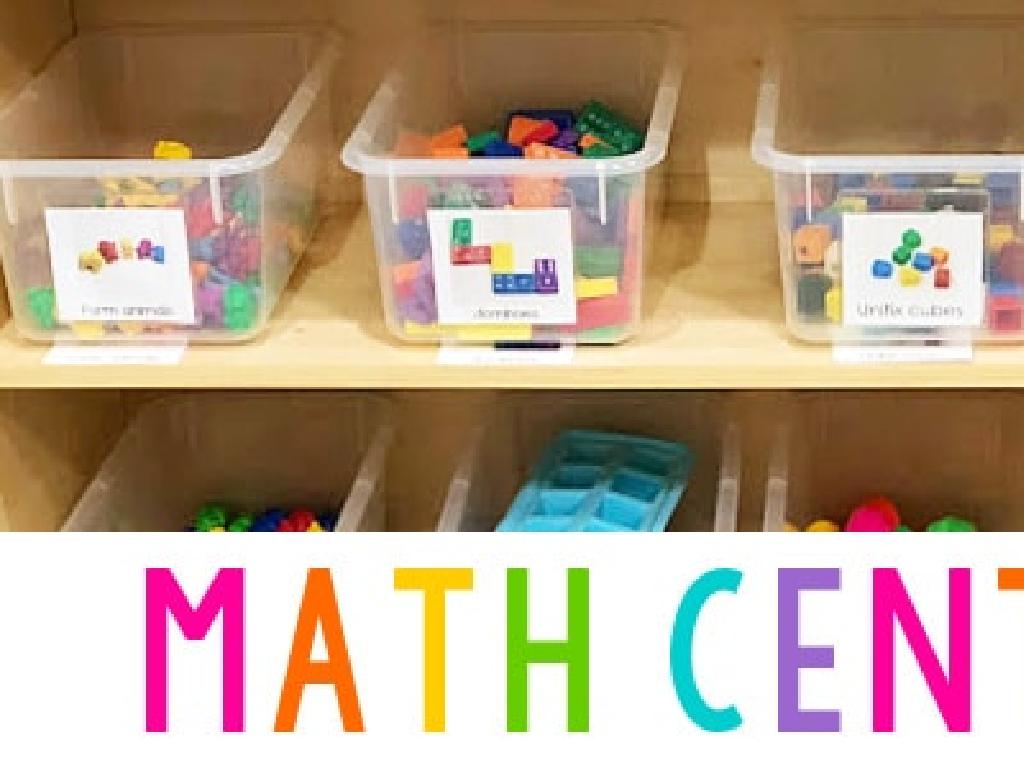Slopes Of Parallel And Perpendicular Lines
Subject: Math
Grade: Eighth grade
Topic: Linear Equations
Please LOG IN to download the presentation. Access is available to registered users only.
View More Content
Introduction to Slopes
– Recap linear equation basics
– Define the concept of slope
– Slope is the ratio of the vertical change to the horizontal change between two points on a line.
– Relate slope to line steepness
– Imagine a hill: A steeper hill has a higher slope value.
– Explore slope in real-life contexts
– Consider a ramp: The slope determines how quickly it rises.
|
Begin with a brief review of linear equations to refresh students’ memory. Introduce the concept of slope as a measure of how much a line tilts or ‘rises over run.’ Explain that slope is calculated as the change in the y-coordinate divided by the change in the x-coordinate between two points. Use everyday examples like hills and ramps to illustrate the concept of slope and its practical applications. Emphasize that understanding slope is crucial for analyzing the relationship between variables in a linear equation. Encourage students to visualize slope as the ‘steepness’ of a line on a graph, which will help them when they learn about the slopes of parallel and perpendicular lines.
Graphing Lines and Understanding Slopes
– Graphing linear equations basics
– Identifying slopes from graphs
– Slope indicates the steepness and direction of a line
– Activity: Practice plotting points
– Use graph paper to plot points and connect them
– Drawing lines on the coordinate plane
– Ensure lines are straight and extend across the plane
|
This slide introduces students to the concept of graphing linear equations and identifying slopes on a graph. Begin with a review of the coordinate plane and how to plot points (x, y). Explain that the slope of a line on a graph represents its steepness and direction, and can be positive, negative, zero, or undefined. For the class activity, provide students with graph paper and ask them to plot given points and draw the corresponding lines. Encourage them to check the steepness and direction of their lines. Offer guidance on how to draw accurate lines that extend across the graph. This hands-on activity will help solidify their understanding of slopes and prepare them for learning about slopes of parallel and perpendicular lines.
Slopes of Parallel Lines
– Criteria for parallelism
– Two lines are parallel if they never meet, no matter how far they extend.
– Parallel lines have equal slopes
– If line m has a slope of 5, a line parallel to m also has a slope of 5.
– Real-life examples of parallel lines
– Railroad tracks and the edges of a bookshelf are examples of parallel lines.
– Applying knowledge of slopes
|
This slide introduces the concept of parallel lines in the context of their slopes. Begin by explaining that parallel lines are lines in the same plane that never intersect. Emphasize that one of the key properties of parallel lines is that they have the same slope. Provide students with relatable examples, such as railroad tracks or lanes on a highway, to illustrate parallel lines in the real world. Encourage students to think of other examples they encounter daily. Conclude by discussing how understanding slopes is useful in determining whether lines are parallel, which is a fundamental skill in geometry and various real-life applications such as construction and design.
Slopes of Perpendicular Lines
– Criteria for perpendicularity
– Two lines are perpendicular if they intersect to form a right angle.
– Slopes’ relationship in perpendicular lines
– If one line has a slope of m, the perpendicular line’s slope will be -1/m.
– Activity: Calculating perpendicular slopes
– Use graph paper to plot lines and find their slopes to see the relationship.
|
This slide introduces the concept of perpendicular lines in the context of linear equations. Begin by explaining that perpendicular lines intersect at a 90-degree angle. Emphasize the mathematical relationship between their slopes: if two non-vertical lines are perpendicular, the product of their slopes is -1. This means if one line has a slope of m, the perpendicular line will have a slope of -1/m. For the activity, provide students with graph paper and ask them to plot various lines using different slopes. Then, have them calculate the slopes of lines that would be perpendicular to their original lines. This hands-on activity will help solidify their understanding of the concept. Offer several examples and encourage students to work in pairs to discuss their findings.
Calculating Slopes of Lines
– Understand the slope formula
– Slope (m) measures steepness: m = (y2 – y1) / (x2 – x1)
– Calculate slopes of lines
– Use coordinates to find the slope of a line
– Work on practice problems
– Apply the formula to solve different types of problems
– Explore various scenarios
– Consider horizontal, vertical, and diagonal lines
|
This slide is focused on teaching students how to calculate the slope of a line using the slope formula. The slope is a measure of the steepness of a line and is calculated by taking the difference in the y-coordinates and dividing it by the difference in the x-coordinates of two points on the line. Students should practice using pairs of coordinates to calculate the slope, ensuring they understand the process and can apply it to various types of lines, including horizontal and vertical lines, where the slope is 0 and undefined, respectively. Provide practice problems that cover a range of scenarios to help students become comfortable with the concept. Encourage students to ask questions and work through problems together for better understanding.
Real-World Applications of Slopes
– Slopes in construction
– Essential for stable structures; roof angles, stairs.
– Road design and slope
– Slope critical for safety, water drainage.
– Activity: Ramp design project
– Design a ramp with a 1:12 slope for accessibility.
– Understanding slope practicality
|
This slide aims to show students the practical applications of slopes in real life, particularly in construction and road design. In construction, understanding slopes is crucial for creating stable structures and determining the correct angles for roofs and stairs. For road design, the slope is important for safety considerations and effective water drainage. The class activity involves designing a ramp with a specific slope, which is a 1:12 ratio, commonly used for wheelchair ramps to ensure accessibility. This activity will help students apply their knowledge of slopes and understand the importance of precision in real-world scenarios. Provide guidelines for the ramp design, including materials, scale, and the math behind calculating the slope. Offer additional examples of slopes in real life, such as ski slopes or slides, to further illustrate the concept.
Class Activity: Slope Investigation
– Find classroom objects with parallel lines
– Find classroom objects with perpendicular lines
– Measure and calculate the slopes
Use a ruler for straight lines, calculate rise over run
– Present your findings to the class
Explain how you determined the slopes and their relationships
|
This interactive class activity is designed to help students understand the concept of slopes in a practical and engaging way. Students will work in pairs to identify objects within the classroom that resemble parallel and perpendicular lines. They will then use rulers to measure these lines and apply the slope formula (rise over run) to calculate the slopes. After the calculations, each pair will present their findings, explaining the process they used to determine the slopes and how they relate to the concepts of parallelism and perpendicularity. For the teacher: Prepare a list of potential objects beforehand to guide students if they struggle to find suitable examples. Also, have a few examples of how to calculate the slope ready to demonstrate. Encourage students to discuss why parallel lines have the same slope and why the slopes of perpendicular lines are negative reciprocals of each other.
Wrapping Up: Slopes of Lines
– Summarize today’s key points
– Parallel lines have equal slopes, perpendicular lines have negative reciprocal slopes.
– Homework: Slope calculation worksheet
– Complete the provided worksheet to practice calculating slopes.
– Practice is key to mastery
– Bring questions to next class
– Review your work and note any uncertainties.
|
As we conclude today’s lesson on the slopes of parallel and perpendicular lines, remind students of the importance of understanding that parallel lines have the same slope, while perpendicular lines have slopes that are negative reciprocals of each other. For homework, students are to complete a worksheet that provides practice on calculating these slopes, reinforcing today’s learning. Emphasize the value of practice in mastering these concepts and encourage students to bring up any questions or difficulties they encounter in the next class. This will help them to clarify their understanding and prepare for more advanced topics.






